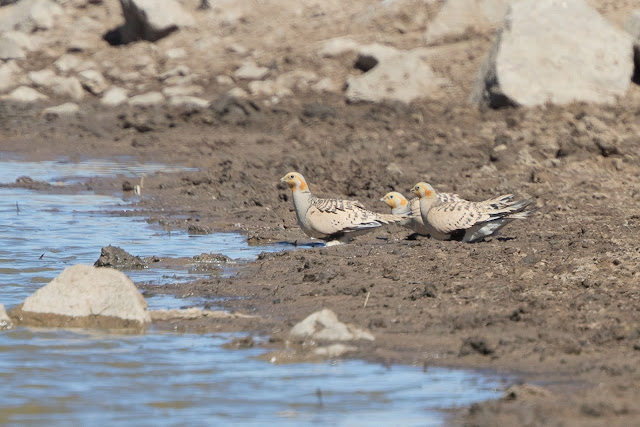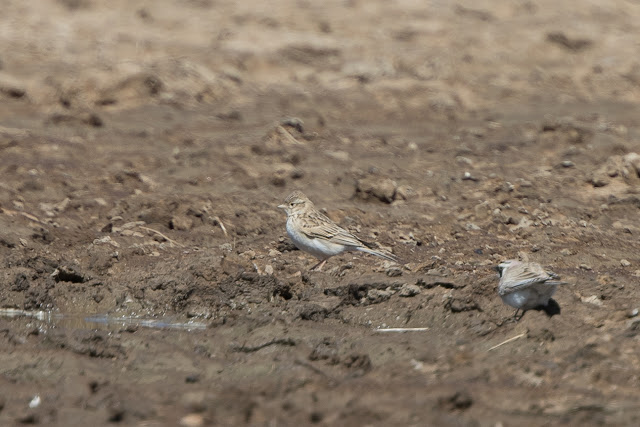Today was mainly a driving day 570km south from Ulaanbaatar to Dalanzadgad passing through the Gobi Desert with a few stops, mainly at lakes, en-route. The landscape was vast, stark and barren, mainly flat with a few rocky outcrops and dominated by gravel plains with sparse grass.
The common birds here were Horned Lark, Asian Short-toed Lark and Isabelline Wheatear and we also saw a good number of Pallas’s Sandgrouse (30+), eight Demoiselle Crane, two Upland Buzzard, Cinereous Vulture, Steppe Eagle and two Saker. Stops at three smallish lakes produced Shelduck, Ruddy Shelduck, Shoveler, Green Sandpiper, Common Sandpiper, Avocet, Temminck’s Stint, Long-toed Stint, Little Ringed Plover, Mongolian Finch, Rock Sparrow, Grey Wagtail and Citrine Wagtail.
At one small roadside lake between Delgertsogt and Mandalgovi (45°55’34” N 106°20’30” E) the vehicles pulled up close to the muddy shore and we waited for Pallas’s Sandgrouse to arrive to drink. Here there were Rock Sparrow, Asian Short-toed Lark, Ruddy Shelduck, Common Shelduck, Teal and five Green Sandpiper while at least 15 Pallas’s Sandgrouse dropped into drink although not close enough to the vehicle for good photographs – they were always very wary of the vehicles.
Citrine Wagtail – Luus Lake
Pairs of Demoiselle Crane were scattered along the roadside
Horned Lark was one of the commonest roadside birds – Lake between Delgertsogt and Mandalgovi
Horned Lark – Lake between Delgertsogt and Mandalgovi
Pallas’s Sandgrouse – Lake between Delgertsogt and Mandalgovi
Pallas’s Sandgrouse – Lake between Delgertsogt and Mandalgovi
Female Pallas’s Sandgrouse – Lake between Delgertsogt and Mandalgovi
Pallas’s Sandgrouse – Lake between Delgertsogt and Mandalgovi
Green Sandpiper – Lake between Delgertsogt and Mandalgovi
Eurasian Teal – Lake between Delgertsogt and Mandalgovi
Ruddy Shelduck – Lake between Delgertsogt and Mandalgovi
Asian Short-toed Lark – Lake between Delgertsogt and Mandalgovi
Demoiselle Crane – Lake between Delgertsogt and Mandalgovi
Demoiselle Crane – Lake between Delgertsogt and Mandalgovi
The Middle Gobi Desert
Steppe Eagle – Gobi Desert
The next lake we stopped at was at Luus (45°30’5″ N 105°45’34” E) and was far larger than the previous lake. The cars drove opposite ways around the shores in order to cover the ground. It was quite a novelty driving through miles of vast desert to be confronted with a lake with teaming birdlife.
Here there were flocks of Shoveler, Pintail and Teal in the open water while around the lake margins were Temminck’s Stint, Long-toed Stint, Marsh Sandpiper, Avocet, Green Sandpiper, Wood Sandpiper and Citrine Wagtail.
Temminck’s Stint – Luus Lake
Temminck’s Stint – Luus Lake
Citrine Wagtail – Luus Lake
Citrine Wagtail – Luus Lake
Citrine Wagtail – Luus Lake
Citrine Wagtail – Luus Lake
Little Ringed Plover – Luus Lake
Long-toed Stint – Luus Lake
Long-toed Stint – Luus Lake
Marsh Sandpiper – Luus Lake
Avocet – Luus Lake
Time was running tight as we wanted some birding time around Delanzadgad before dark and so we left Luus Lake reluctantly and continued our journey south-west.
The desert scenery was amazing with barren landscapes dotted with camels and as we continued eventually we saw the mountains of Gobi Gurvan Saikhan National Park with the town of Dalanzadgad situated at its northern base.
Camel – Gobi Desert
Camel – Gobi Desert
Gobi Desert
Gobi Desert
Gobi Desert with the mountains of Gobi Gurvan Saikhan above Delanzadgad coming into view
We arrived at our Guest House at Dalanzadgad at around 17:30. The guest house is owned by Tumen and we soon found our bed space and settled in, I opted for a bed on the landing for some unknown reason while others shared. We spent a couple of hours settling in and birding from the balconies before heading in to the adjacent habitat.
We then spent the rest of the day birding the small lake and area of scrub opposite the guest house (43°33’7″ N 104°25’1″ E). Highlights included Hobby, Osprey, Long-toed Stint, Citrine Wagtail, Isabelline Shrike, Pale Martin, Pallas’ Bunting and Red-throated Thrush. Dalanzagad is a small town located close to a mountain range of the Gobi Gurvan Saikhan and within the middle of the Gobi Desert and as a result any small areas of scrub attract migrating birds.
Tumen has put considerable effort into influencing the creation of habitat for birds on this edge of the desert, and hence the areas around the Guest House are a magnet for migrant birds and we enjoyed a fantastic couple of hours birding before the sun went down.
Isabelline Shrike – Delanazadgad
Isabelline Shrike – Delanazadgad
Isabelline Shrike – Delanazadgad
Ruddy Shelduck – Delanazadgad
Snipe species (Common Snipe?) – Delanzadgad
Snipe species (Common Snipe?) – Delanzadgad
Isabelle Shrike – Delanzadgad
Simon Colenutt
I began birdwatching at the age of nine when living on the Isle of Wight. After obtaining a copy of the Isle of Wight Bird Report from 1976 I realised that Manx Shearwater, Arctic Skua, Pomarine Skua and Black Tern were regularly seen at St.Catherine's Point, only five miles from my home village of Chale Green. To a nine year old these birds were near mythical and so I just had to go and try to see them. Little did I know that these birds were seasonal and after a long winter of seeing nothing I eventually started to bump into other birdwatchers as March drew to a close. It was then that Dave Hunnybun, Dave Wooldridge, Paul Castle, Peter Gandy and Audrey Wilkinson introduced me to the art of seawatching and the joys of bird migration, I have not looked back since.








































Leave a Reply